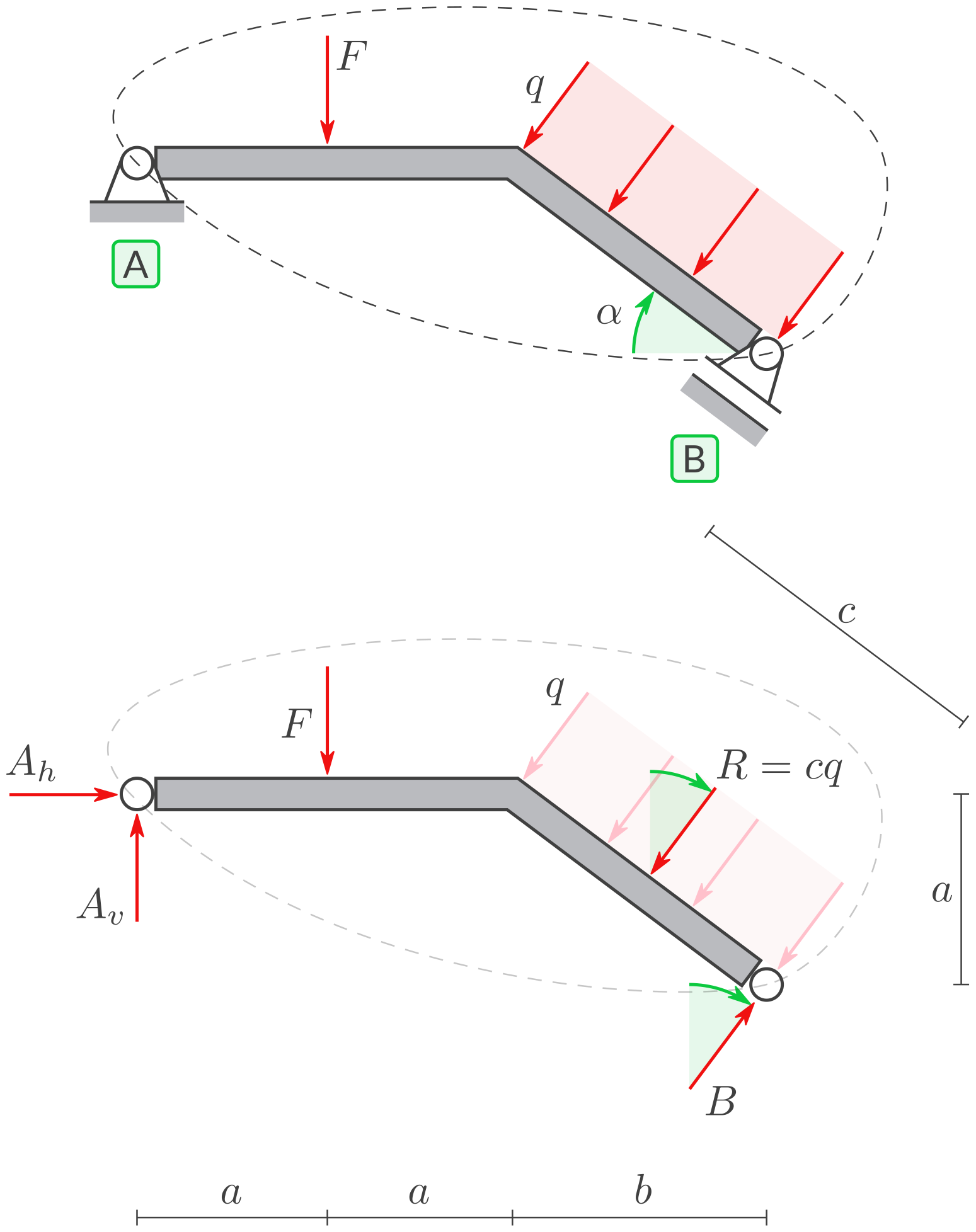1.5.A

Gegebene Symbole: \(F, q, a.\) Und davon abhängig \(b=\tfrac 4 3 a.\)
Gegebene Größen:
Und davon abhängig:
Berechnen Sie die Lagerreaktionen. Gehen Sie wie folgt vor.
a) Geometrie
Für die gegebenen Symbole: Berechnen Sie:
Und mit diesem \(c\):Lösung
b) Freikörperbild
Berechnen Sie die Resultierende der verteilten Kraft.
Schneiden Sie an den Lagern frei, so dass die Auflagerkräfte sichtbar werden.
Zeichnen Sie den Balken in einem Freikörperbild.
c) Lagerreaktionen
Für die gegebenen Größen: Berechnen Sie alle Lagerreaktionen.
Nachfolgend ein Programm, dass Sie ausführen können: Auf dem PC z.B. mit Anaconda. Im Browser (online) in drei Schritten: Copy: Source Code in die Zwischenablage kopieren. Paste: Source Code als Python-Notebook einfügen z.B. auf: JupyterLite oder JupyterLab oder Play: Ausführen. Statt SymPy lieber anderes CAS (Computeralgebrasystem) verwenden? Eine Auswahl verschiedener CAS gibt es hier.SymPy
from sympy.physics.units import *
from sympy import *
# Units:
(k, M, G ) = ( 10**3, 10**6, 10**9 )
(mm, cm) = ( m/1000, m/100 )
Pa = newton/m**2
MPa = M*Pa
GPa = G*Pa
kN = k*newton
deg = pi/180
half = S(1)/2
# ---
a, b = var("a, b", positive=True)
F, q = var("F, q", real = True)
sub_list=[
(F, 100*newton),
(q, 24*newton/m),
(a, 3*m),
]
b = 4*a/3
c = sqrt(a**2 + b**2)
pprint("R:")
R = c*q
tmp = R
pprint(tmp)
pprint("R / N:")
tmp = tmp.subs(sub_list)
tmp /= newton
pprint(tmp)
# Unknowns:
Ah, Av, B = var("A_h A_v B")
pprint("\nca, sa:")
ca, sa = b/c, a/c
pprint(ca)
pprint(sa)
eq1 = Eq(0, Ah + B*sa - R*sa)
eq2 = Eq(0, F - Av - B*ca + R*ca)
eq3 = Eq(0, c*B - c/2*R + a*F - 2*a*Av)
# Solve for unknowns:
eqs = [eq1, eq2, eq3]
sol = solve(eqs, [Ah, Av, B])
pprint("\nAh:")
tmp = sol[Ah]
pprint(tmp)
pprint("\nAh / N:")
tmp = tmp.subs(sub_list)
tmp /= newton
pprint(tmp)
pprint("\nAv:")
tmp = sol[Av]
pprint(tmp)
pprint("\nAv / N:")
tmp = tmp.subs(sub_list)
tmp /= newton
pprint(tmp)
pprint("\nB:")
tmp = sol[B]
pprint(tmp)
pprint("\nB / N:")
tmp = tmp.subs(sub_list)
tmp /= newton
pprint(tmp)
R:
5⋅a⋅q
─────
3
R / N:
120
ca, sa:
4/5
3/5
Ah:
9⋅F 25⋅a⋅q
- ─── + ──────
49 98
Ah / N:
0
Av:
37⋅F 50⋅a⋅q
──── + ──────
49 147
Av / N:
100
B:
15⋅F 365⋅a⋅q
──── + ───────
49 294
B / N:
120

